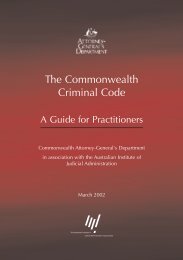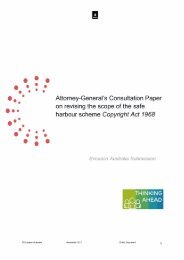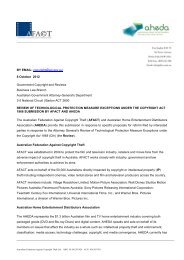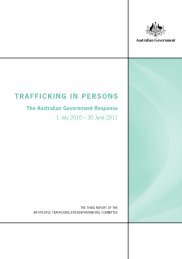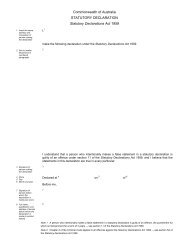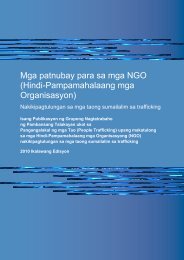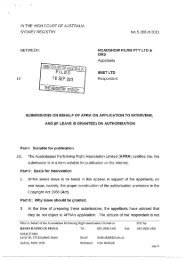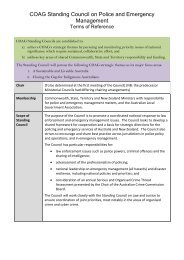Normann Witzleb [PDF 657KB] - Attorney-General's Department
Normann Witzleb [PDF 657KB] - Attorney-General's Department
Normann Witzleb [PDF 657KB] - Attorney-General's Department
You also want an ePaper? Increase the reach of your titles
YUMPU automatically turns print PDFs into web optimized ePapers that Google loves.
irrelevant inquiry in deciding whether the information is entitled to be<br />
protected. 91<br />
54 It would be desirable if the Australian privacy cause of action had a similar scope and<br />
effect. Considering that the term ‘privacy’ has not been defined in the ALRC and the<br />
NSW proposals, it can readily be understood to include a person’s reasonable<br />
expectation that no untrue information is published about himself or herself.<br />
55 The misappropriation of a person’s name, likeness or other characteristics for<br />
financial gain raises issues that are beyond the scope of this submission. These wrongs<br />
affect a plaintiff’s personality interest but also his or her commercial and proprietary<br />
interests. As long as the proper limit of protection in relation to these phenomena<br />
continues to be uncertain, 92 it is preferable that statutory reform adopts a cautious<br />
approach. To that extent, it may be appropriate for the statute to deal with the privacy<br />
aspects of these wrongs and leave the proprietary considerations to further<br />
developments in the courts.<br />
56 The current formulations of both the ALRC and NSWLRC allow for this flexibility and<br />
should therefore be preferred over the VLRC recommendation for two separate causes<br />
of action.<br />
57 The ALRC recommends the inclusion of a non-exhaustive list of typical privacy<br />
infringements, while the NSWLRC proposal contains no such list. Such a list at best<br />
provides some limited and initial guidance to interpreting the statute. As soon as a body<br />
of jurisprudence develops, the list is likely to become obsolete. This, combined with the<br />
doubtful normative value of a non-exhaustive list, suggests that it may be unnecessary<br />
to include it in the legislation.<br />
10. What should be included as defences to any proposed cause of action?<br />
A. Consent<br />
The proposals<br />
58 The NSWLRC proposal provides that conduct that has been expressly or impliedly<br />
consented to does not invade an individual’s privacy. 93 The NSWLRC thus makes<br />
consent an ‘essential element of the cause of action’ 94 and requires the plaintiff to<br />
91 McKennitt v Ash [2008] QB 73; [2006] EWCA Civ 1714, [86]. Buxton LJ indicated that it may be an<br />
abuse of process when falsity was the nub of the claimant’s complaint and breach of confidence were<br />
relied on in order to avoid the rules relating to defamation ([78]-[80]). See also WER v REW [2009] EMLR<br />
304; [2009] EWHC 1029 (QB).<br />
92 For a comprehensive analysis of English law, see S Smith, Image, Persona and the Law, 2 nd ed, Sweet &<br />
Maxwell, London, 2008.<br />
93 NSW Draft Bill, cl 74(4).<br />
94 NSWLRC Report, at [5.51].<br />
20


![Normann Witzleb [PDF 657KB] - Attorney-General's Department](https://img.yumpu.com/26247895/20/500x640/normann-witzleb-pdf-657kb-attorney-generals-department.jpg)

